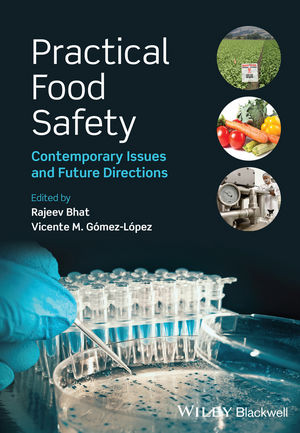Microbiological Risk Assessment: Origins, Current Status, and Future Challenges
Origins, Current Status, and Future Challenges

The process for evaluating chemicals in foods and the environment advanced significantly in 1983 when the National Research Council (NRC) published the first edition of its publication Risk Assessment in the Federal Government: Managing the Process. This publication, which became known as “The Red Book,” detailed a risk assessment approach to making decisions related to the safety of potentially toxic chemicals based on a four-step process consisting of hazard identification, dose response assessment, exposure analysis, and characterization of risks.1 The process has continued to evolve as both the toxicology and risk assessment methods have become increasingly sophisticated, and the approach has been adopted internationally by national governments and intergovernmental food standards organizations such as Codex Alimentarius Commission (CAC). In 1994, CAC requested that the UN Food and Agriculture Organization (FAO) and the World Health Organization (WHO) convene an “Expert Consultation on the Application of Risk Analysis to Food Standards Issues.”2 The scope of the consultation included chemical compounds such as food additives, naturally occurring toxins, mycotoxins, and marine biotoxins. The consultation also evaluated the use of risk analysis for pathogenic biological agents such as bacteria, viruses, helminths, and protozoa. The report provided specific recommendations related to chemicals that were in keeping with the protocols in the NRC Red Book and provided a procedural framework to accommodate the globalization of the process for development of Codex Alimentarius standards.2 The recommendations for biological agents acknowledged the need for a similar framework but indicated that the complex behavior of biological agents made it unlikely that a fully quantitative risk analysis approach could be achieved in the near term. However, the report fully recommended the investment in developing such capabilities.
Realization of the WHO/FAO expert consultation’s recommendations came about much more quickly than anticipated, with the first examples of quantitative microbiological risk assessment modeling applied to water and seafood appearing in the early 1990s,3 and by the mid-1990s, quantitative consideration of microbiological risks associated with foods began to be published.4 Several factors encouraged the rapid advancement. One of the key factors was the signing of the World Trade Organization (WTO) “Agreement on Sanitary and Phytosanitary Measures,” which was finalized in 1994 and implemented in 1995. The agreement includes specific statements that (1) require the use of risk assessment as a tool when the WTO arbitrates sanitary and phytosanitary (SPS)-related trade disputes, and (2) identified the CAC as the international standards-setting body for SPS issues related to food. As mentioned above, the CAC had already adopted a risk assessment approach for toxic chemicals but did not have a similar program for microbiological hazards. This stimulated the national governments of most developed countries to begin to develop risk assessment approaches for microbiological food safety standards. At the same time, national governments began to require formal risk assessments for the development of new regulations. For example, in the United States, the U.S. Department of Agriculture (USDA) Reorganization Act of 1994 required a formal risk assessment be conducted for any proposed major regulation that included public health or environmental concerns. In subsequent years, this was expanded to other government regulatory agencies, making conducting risk assessments as a requirement when proposing a new regulation. The two other factors that came together at that time were more technical in nature. During the late 1980s and the early 1990s, there was an international effort to develop mathematical models of microbial growth, survival, and inactivation. While this effort, which was ultimately coined “predictive microbiology,” began much earlier in developing models for thermal inactivation, the work during the 1990s included a large variety of foodborne pathogens and was developed in a manner that could be applied to a wide range of foods. Early in this process, it was recognized that such tools were a key to the development of quantitative microbial risk assessment.4–7 The final factor was the amazing advancements in computational tools that gave microbiologists, food scientists, and public health researchers the ability to develop complex stochastic risk assessment models.
Microbial Risk Assessment Resources
FAO on scientific advice:
- www.fao.org/food-safety/scientific-advice/en
- www.fao.org/food/food-safety-quality/scientific-advice/jemra/en
The European Food Safety Agency (EFSA):
The International Commission on Microbiological Specifications for Foods (ICMSF):
The Society for Risk Analysis (SRA):
Microbiological risk assessment:
Current Status
Progress in food safety microbiological risk assessment was rapidly adopted by food safety government agencies in the United States,8,9 in part because of their experience with risk assessments associated with chemical compounds in foods, and in part because of the requirement for risk assessment in developing new food safety regulations. The first quantitative microbial risk assessment (QMRA), Salmonella Enteritidis Risk Assessment: Shell Eggs and Egg Products, was released by the USDA Food Safety and Inspection Service (FSIS) in 1998. It was the first “farm-to-table” risk assessment used to identify and evaluate enhanced food safety strategies. This was followed in 2001 by USDA-FSIS’s Risk Assessment of the Public Health Impact of Escherichia coli in Ground Beef. At the same time, the U.S. Food and Drug Administration (FDA) initiated its QMRA program, following a formal framework, “Initiation and Conduct of All ‘Major’ Risk Assessments within a Risk Analysis Framework” in 2002 that reflected the regulatory process, that is, a formal public announcement (with a call for data) that a QMRA was being initiated, the publication of a draft risk assessment for public comment and peer review, and the transmittal of the risk assessment to the risk managers at FDA as a tool for developing new risk management programs. FDA’s first two QMRAs were the 2003 FDA/FSIS Quantitative Assessment of Relative Risk to Public Health from Foodborne Listeria monocytogenes Among Selected Categories of Ready-to-Eat Foods, and the 2005 Quantitative Risk Assessment on the Public Health Impact of Pathogenic Vibrio parahaemolyticus in Raw Oysters. Since then, a variety of QMRAs have been performed or funded by USDA-FSIS on risks such as bovine spongiform encephalopathy, Salmonella in pork products, interagency avian influenza virus in poultry, Campylobacter in poultry, Listeria monocytogenes in retail delicatessens, and risks associated with applying inspection to Siluriforme fish. Similarly, FDA has performed a series of microbiological risk assessments such as for Escherichia coli O157:H7 in apple cider, foodborne illness associated with untreated soil amendments, hepatitis A virus associated with fresh and fresh-cut produce, and norovirus transmission in food establishments. In addition, FDA developed iRISK, web-based software for performing risk assessments that the agency has made available to the public.
At the international level, the advancement of microbiological risk assessment has been fostered by the Joint FAO/WHO Expert Meetings on Microbiological Risk Assessment (JEMRA) that were initiated in 2000. JEMRA joined the previously established Joint FAO/WHO Expert Committee on Food Additives, which focuses on the chemical safety of foods. These programs were initiated in response to the recommendations of the 1995 WHO/FAO expert report on risk analysis. Both programs have dual functions of providing risk assessment expertise and knowledge for the various committees of the CAC and fostering food safety risk analysis through advancements in the concepts, resources, and methods in the three components of risk analysis: risk assessment, risk management, and risk communication. The output of JEMRA over the past 20 years has been the development of international risk assessments related to pressing issues facing the CAC, the development of guidance documents related to risk analysis, and fostering an international network of risk assessment experts and practitioners. See “Microbial Risk Assessment Resources,” right, for readily available, globally accessible sites. National governments are also increasingly adopting risk-based approaches to drafting food safety laws and regulations.
While much of the original work in QMRA was performed by national governments, over the past 20 years, there has been ever increasing involvement and contributions by academics. From a personal standpoint, my reference database on QMRA citations is approaching 1,000 reports and articles, and my database on predictive microbiology is approaching 2,000 contributions. This reflects the fact that both areas have become recognized subdisciplines within food microbiology. Both are being taught as part of the overall approach to modern food microbiology, reflecting the steady movement of food microbiology to a more quantitative science. However, this should not be surprising, considering the historical interaction between food engineering and food microbiology in the development of the processing models at the heart of food manufacturing. Over the past decade, we have seen microbial food safety risk assessments addressing bacteria, viruses, mycotoxins, protozoa, parasites, toxic algae, and even prions. We have seen the publication of increasingly sophisticated product/pathogens pathway risk assessments, quantitative risk-ranking risk assessments, supply chain models, systematic reviews/meta-analyses, and risk/risk “trade-off” assessments. While finishing this article, I participated in the 2020 Annual Meeting of the International Association for Food Protection, my first virtual scientific meeting. As I was deciding on the sessions I would join from home, I was struck by the number of symposia and sessions devoted to both microbiological and chemical risk assessments. It was quite evident that risk analysis has become a standard tool for discussing strategies for new food safety programs and is being embraced by the next generation of future scientific leaders of food safety programs.
The food industry has likewise shown an increased interest in risk-based approaches to food safety risk management. This has been particularly true for the larger food companies, which have the resources to develop their own risk assessment expertise. However, individual corporations have generally maintained a low profile related to the development of risk models for their products and facilities. Instead, they have worked through trade organizations such as the International Life Sciences Institute, the Consumer Brands Association (formerly the Grocery Manufacturers Association), the United Fresh Produce Association, the Produce Marketing Association, the North American Meat Institute, and the American Dairy Products Institute. These organizations have been particularly helpful in getting support for research and data acquisition. For example, I had the honor of leading a multiple-university, 5-year, USDA Specialty Crop Research Initiative-funded public-private project focused on acquiring the data and knowledge needed to develop risk-based controls for enhancing the safety of fresh and fresh-cut produce. Involvement of the produce industry was critical in getting support from USDA, as well as getting access to agricultural and food manufacturing facilities and acquiring industry microbiological data that were critical to developing risk assessments and comparing different risk management options on both a regional and national basis. My experience with QMRAs has been that the most useful risk analysis activities have actively involved academia, regulatory agencies, and food industry organizations.
Future Challenges
The rapid emergence of microbiological risk assessment as a tool for food safety decision making has been accompanied with certain growing pains that are likely to impact its future applications. Some of these pains are related to the risk assessment methods and data availability, but most of them involve the interface between risk assessment and the two other components of risk analysis: risk management and risk communication. Going into detail on the large number of factors that could affect future uses of QMRAs would probably require an extensive treatise for it to be reasonably predictive and would certainly be longer than I have room for here. So instead, I will briefly explore a few of the areas that are routinely discussed by risk assessors and the people who are interested in using risk assessment to enhance food safety.
Most people are poor judges of risks and probabilities: This has been verified by numerous behavior studies. This is readily obvious if you think of the number of states that rely on lotteries to help fund their budgets. Knowing that the odds of winning are vanishingly small does not stop millions of people from playing each week.
How to best communicate mathematics: Explaining risks accurately requires the consideration of the mathematics of probability. However, the fastest way to have the eyes of most audiences glaze over is to present a mathematical equation. Furthermore, it is critical that communication skills be tailored for the specific audiences being addressed. This need often results in tension and a degree of frustration between the risk assessors who are reporting their findings and the various stakeholders who are receiving them.
Risk mitigation does not mean zero risk: No intervention or prevention program absolutely eliminates food safety risks. The risk that remains after initiating a risk management program is referred to as the “residual risk.” The emergence of QMRA has allowed the residual risk to be quantitatively expressed, and while small, it is not zero. This again results in a communication issue since consumers, business executives, and legislators often view foods as being safe (no risk) or unsafe (any risk).
What do we do with small food businesses? Foods are one of the few remaining areas where an individual can start with a good idea for a new product and develop it into a multimillion-dollar business. While a relatively small number of corporations produce and market much of the food in the United States, there are thousands of small to medium-sized companies that are integral parts of the food industry. However, they generally lack the resources to be able to take advantage of QMRA capabilities. However, I predict that simplified software or risk assessment services that would allow small businesses to develop their own models could be an area for IT entrepreneurs. An immediate question would be how likely are regulatory agencies to accept these as a risk-based tool? For example, would the agencies accept the finding that hazards are not significant and thus don’t require a Critical Control Point or Preventive Control?
Does a risk assessment put my company in increased jeopardy in product liability cases? A concern that I have heard from small and large companies alike is a concern that if they conduct a QMRA on their products, such that the residual risk can be calculated, that this could be used as evidence that they knew ahead of time that adverse events could occur, thereby opening them up to liability and even criminal legal actions. This is an area that would benefit from discussion by industry, regulatory agencies, and product liability/personal injury lawyers.
Interpreting and communicating a QMRA: As mentioned above, at the completion of a risk assessment, risk assessors must pass their findings along to a variety of audiences such as the CEO of a company, FDA or FSIS, major supermarket chains that are placing the food onto the market, and consumers who will be using the products. Each of these groups has different interests, backgrounds, biases, and vocabularies that have to be understood and addressed correctly. Further, when developing communication approaches, it’s also necessary to take into account the background of the risk assessors. For example, a QMRA developed by a team of government risk assessors is likely to emphasize and interpret the results in differing contexts than would an assessment conducted by university professors and their graduate students, or by corporate risk assessors who have expert knowledge of the details of the food products but may be less familiar with the medical literature used to assess the adverse effects integral to understanding and interpreting a risk assessment. Does this mean that risk assessments may have to go for public comment and peer review in a manner like the process used by U.S. regulatory agencies?
Undoubtedly, other challenges will arise in the next decade in the evolution of QMRA. I would love to hear what others are thinking and encourage you to send me an email about the challenges you anticipate as we apply these tools to improving food safety programs.
Conclusions
It has been a fascinating journey, starting from an idea in the minds of a small international consortium of food microbiologists, risk assessors, and engineers in the 1980s and evolving to a mature set of tools and concepts that have become integral to developing food safety systems. However, it is also important to keep focused on the ultimate goal, which is to continually improve our ability to provide safe food to increasing numbers of highly diverse peoples who depend on such decisions in a world straining to maintain sustainable agricultural production. With this at stake, it’s important that we “not lose sight of the forest for the trees.”
Acknowledgments
I would like to express my appreciation and thanks for all the risk assessors, risk managers, risk communicators, lawyers, and food safety/public health scientists who have taught me so much over the past 50 years.
References
1. NRC, Risk Assessment in the Federal Government: Managing the Process (Washington, DC: National Academy Press, 1983).
2. WHO/FAO. 1995. Application of Risk Analysis to Food Standards Issues: Report of the Joint FAO/WHO Expert Consultation. March 13–17, Geneva, Switzerland.
3. Rose, J.B., C.N. Haas, and S. Regli. 1991. Am J Public Health 81(6):709–713.
4. Whiting, R.C. and R.L. Buchanan. 1997. Int J Food Microbiol 36:111–125.
5. Buchanan, R.L. and R.C. Whiting. 1996. J Food Prot 59(13):31–36.
6. Buchanan, R.L. and R.C. Whiting. 1998. J Food Prot 61(11):1531–1534.
7. Whiting, R.C. and R.L. Buchanan. 1997. “Predictive Microbiology, HACCP, and Risk Assessment.” Proceedings of the International Symposium on Predictive Microbiology Applied to Chilled Food Preservation, Quimper, France, 105–112.
8. Buchanan, R.L. and S.B. Dennis. 2001. J Assoc Food Drug Off 65(3):36–46.
9. Dennis, S.B., R.L. Buchanan, and A.J. Miller. 2001. Food Safety Magazine 7(6):14–17, 60.
Robert L. Buchanan, Ph.D., is professor emeritus in the Department of Nutrition and Food Science & Center for Food Safety and Security Systems at the University of Maryland. He can be reached at rbuchana@umd.edu.
Looking for a reprint of this article?
From high-res PDFs to custom plaques, order your copy today!









